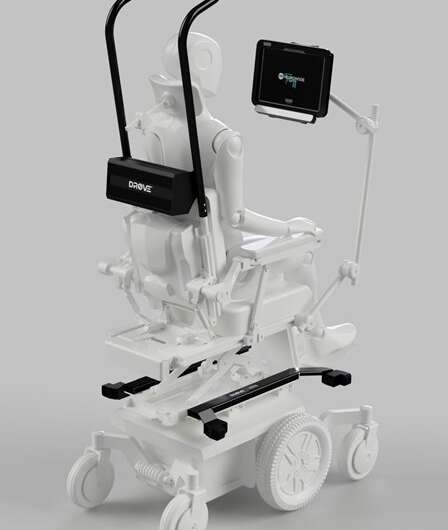This article has been reviewed according to Science X's editorial process and policies. Editors have highlighted the following attributes while ensuring the content's credibility:
fact-checked
trusted source
proofread
Artificial intelligence wheelchair aims to put users in control

More than a billion people around the globe need assistive technology to go about everyday tasks independently. A new artificial intelligence (AI) wheelchair is taking assistive technology a step further and giving people their freedom back.
Assistive technology is any tool that helps people complete everyday tasks they would otherwise find difficult or impossible due to disability. These tools include glasses, hearing aids, prostheses, pill organizers, wheelchairs or other mobility aids, communication aids and much more.
For many, whether suitable assistive devices exist, or if they have access to them, can greatly impact their quality of life. With the expanding capabilities of AI and internet of things (IoT) devices, there are growing opportunities to improve assistive technologies and make people's lives easier.
Wheel in the artificial intelligence
The ability to move around unassisted is key to independence and important to our quality of life. Mobility is one area where advanced machine learning, IoT and navigation technologies can make a big difference.
Across the globe about 1.85 percent of people need a wheelchair. More than 180,000 Australians use wheelchairs, with more than 25,000 people requiring electric or power wheelchairs. But traditional steering systems, like joysticks, do not spark joy for all wheelchair users—and for good reason. Not everyone can use them.
Joysticks were originally made for steering aircraft. To safely, easily and comfortably navigate a wheelchair with one, you typically need considerable hand and/or wrist mobility. This is not something everyone who uses a wheelchair necessarily has. Conditions like motor neuron disease, multiple sclerosis, spinal muscular atrophy, cerebral palsy, spinal cord injury and arthritis can all affect hand function.
For some people, a lack of suitable assistive technologies means they rely on caregivers' assistance to move around their home. This severely restricts their freedom and independence, impacting even the small everyday actions able-bodied people may take for granted. For example, if their caregiver is in another room or completing a different task, they might have to wait just to move so the sun isn't in their eyes.
New technologies specifically developed for assistive purposes could help many people move independently around their homes for the first time.
Innovation in motion
Control Bionics is an Australian company specializing in advanced assistive technology. The company's NeuroNode wireless wearable device allows people to use signals from their brain to complete tasks that would otherwise require a keyboard, mouse, joystick or touchscreen. Users can control a cursor on a smartphone or computer using eye-tracking and then select actions with a neural signal.
While mind-controlled technology might seem like something out of science fiction, the idea itself is relatively straightforward. The technology picks up signals from the brain that would control a muscle, even if the muscle itself isn't fully functional, and uses it as an input on a smart device.
This can be lifechanging when it comes to communication and social interaction. Using this device, people who can't control the muscles involved in speech can effectively communicate through text and text-to-speech. They can also control linked devices around the home, from TVs to smart door handles.
Control Bionics recognized how useful this type of mind-technology interface could be for wheelchair users who can't use traditional steering systems. To develop the technology needed, our SME Connect team connected the small business with Deakin University.
Mind-controlled mobility
Control Bionics and researchers from Deakin University's Applied AI Institute (A2I2) developed a world-first autonomous driving wheelchair module called DROVE.
Dr. Srikanth Thudumu is the lead researcher for DROVE.
"At A2I2, we developed a state-of-the-art digital twin with a user interface that displays a virtual representation of a user's home," Srikanth said.
Control Bionics then integrated the digital twin into a physical wheelchair and DROVE was trialed in users homes.
DROVE uses a wheelchair-mounted digital camera system, the NeuroNode interface, and sensors throughout the home to achieve centimeter-accuracy. It can navigate doorways and tight hallways, reverse and detect and stop for unexpected obstacles. The system can also make tasks easier by ensuring the wheelchair is always in the correct position.
"This interface has enabled users to select a destination, while our advanced control system ensures safe navigation within the home. Additionally, we have incorporated an override mechanism that allows users to regain manual control at any time," Srikanth said.
Users who tested the technology said by allowing them to move freely around the home, the system gives them life-changing independence and control over their lives.
The DROVE system will be available to those who need it under the National Disability Insurance Scheme. Everyone involved is keen to see this Australian developed and built innovation rolled out in more homes, helping people around Australia and the globe.
Our SME Connect Facilitator Angela Wu said it has been a pleasure being involved with the project.
"As an SME Connect Facilitator, it's so rewarding to support this kind of innovation," Angela said.
"The launch of DROVE is a testament to Australia's talented research community and innovative companies. It also shows what we can achieve with collaboration and a vision to use technology to change people's lives for the better."





















